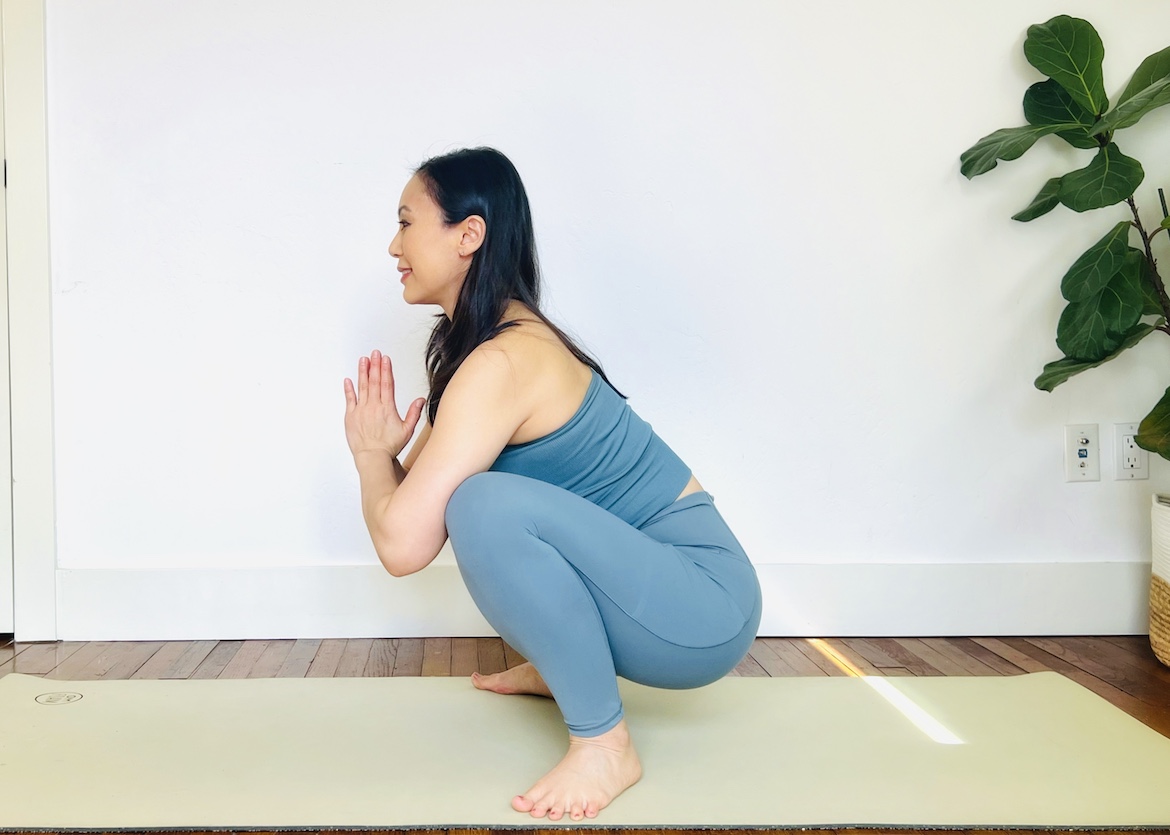Crow pose in yoga, known in Sanskrit as bakasana, is a hard-to-nail arm balance that’s on many yogis’ bucket lists. Those who’ve mastered it swear that it’s all about perfecting your form, but for many of us, the pose often serves as a call to go splat on the mat. But crow pose is more than just an intimidating arm balance—it’s your chance to take flight.
This pose masterfully blends strength, agility, and mental focus, making it an ideal launchpad for both yoga novices and adept practitioners.
Carolina Vivas, co-owner of büddhi moves and co-founder of FlowLIFT Fitness says, “crow pose is much more than an arm balance; it’s a deep engagement of the abdominal muscles while also stretching from the low back to the shoulder blades.” As a key posture in yoga arm balances, crow pose is an invitation to harmoniously meld your physical skill with mental sharpness.
So, is crow a difficult yoga pose? Yes—but it’s more accessible than you think. With some practice and the right technique, you’ll be amazed at how quickly you can learn to launch gracefully into crow pose.
“Not being afraid to fall in this practice can translate to greater bravery in other areas of your life.”—Carolina Vivas
Let’s unlock this advanced yoga pose, which pushes you to challenge your limits and reach new heights of strength, agility, and focus. Whether it’s your maiden voyage or you’re a frequent flier, crow pose launches you into an empowering journey, enhancing your practice with the exhilarating sensation of defying gravity.
Benefits of crow pose
Strengthens abdominal muscles
Crow pose is specifically effective for strengthening all “four layers of abdominal muscles, from the sides to the front,” says Vivas. She emphasizes that this comprehensive engagement makes it a “crucial element for an effective yoga practice.”
Builds upper-body strength
This pose is a great yoga move for boosting arm and wrist strength, which makes it an excellent choice for those seeking to develop resilience and strength in the upper body.
Improves balance and stability
Crow pose uniquely challenges and enhances balance and stability, engaging both the body and the mind. This dual engagement helps in maintaining a strong, rooted stance during your yoga practice.
Increases concentration and mental focus
Vivas says that “mastering crow pose helps you move from your center, staying rooted and strong in your practice, while also learning how to keep your breath calm and steady in a difficult pose.” As you strive to maintain equilibrium in crow pose, your concentration and mental focus are naturally heightened.
Promotes balanced growth and well-being
Regularly practicing crow pose in yoga cultivates a balance between physical strength and mental well-being. By engaging the core, arms, and wrists, it strengthens the body while improving balance and concentration, sharpening the mind. This combination of physical and mental discipline makes crow pose a uniquely challenging and enriching part of a yoga practice.
Step-by-step technique for crow pose
Breaking crow pose down into steps is the best way to practice getting into this asana. Take your time, and notice which, if any, part of the movement feels tough.
Step 1
Start in a squat position on your yoga mat. Take a few deep breaths to center yourself and bring your mind into the present moment.
Step 2
Place your hands in front of you on the mat, shoulder-width apart for stability. Gently place your knees on your upper arms, aiming to position them as close to the armpits as possible for optimal balance.
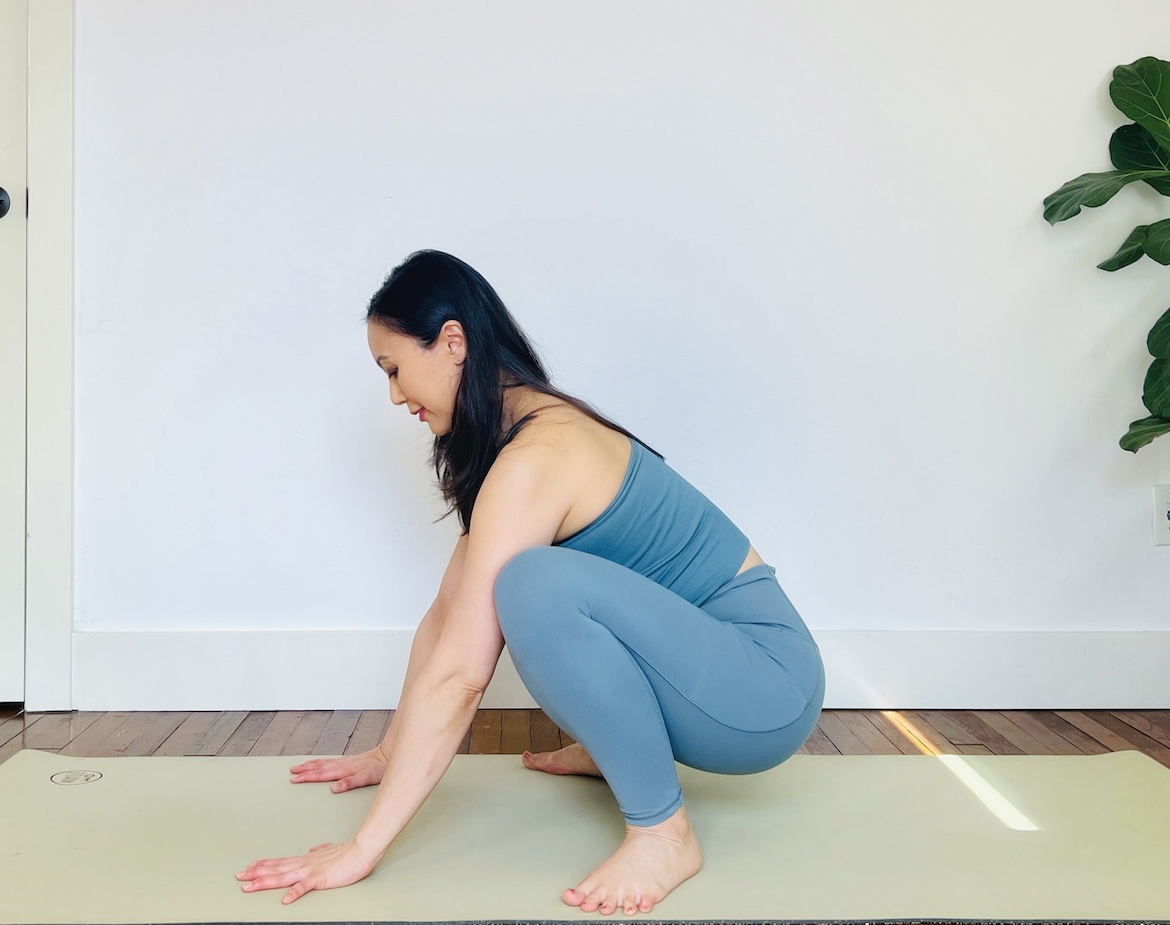
Step 3
Keep your elbows bent to start out so you have a shelf for your knees. Gradually lean forward, shifting your weight onto your hands, while simultaneously lifting your feet off the ground one at a time.
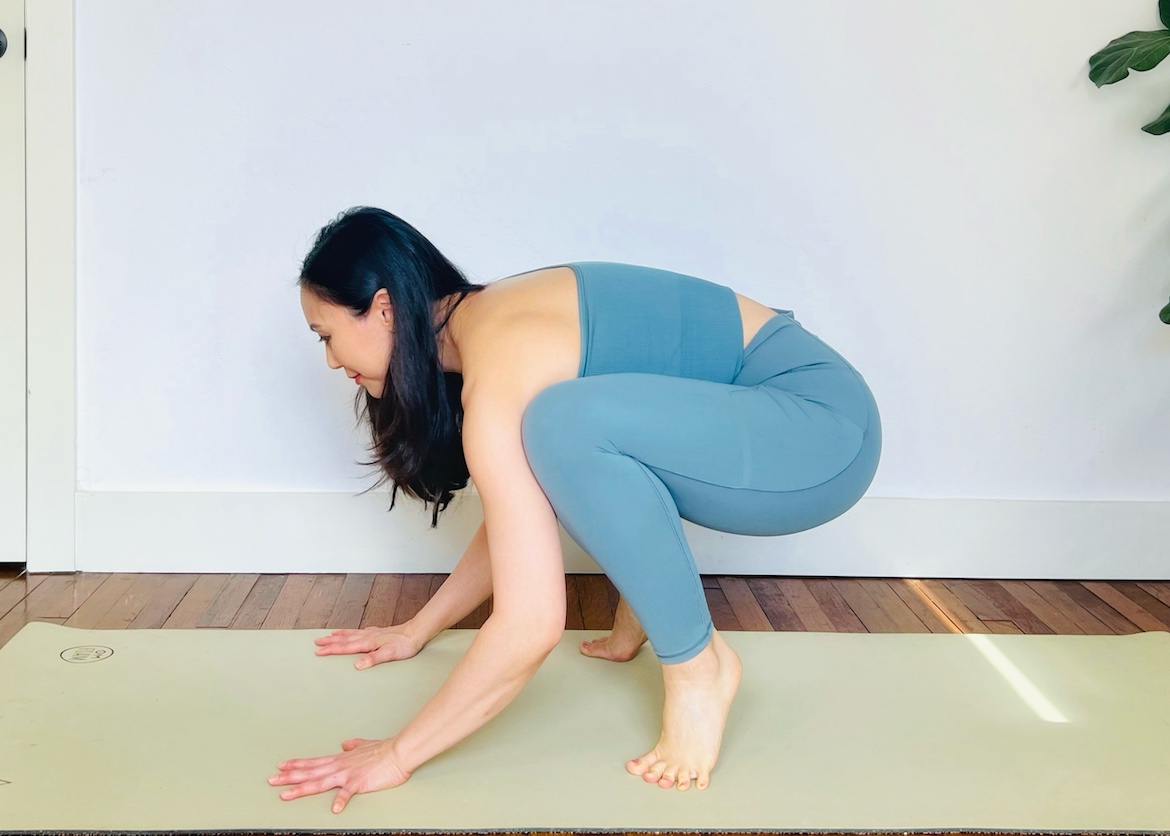
Step 4
Actively engage your core muscles to stabilize your body in this position and keep your gaze forward to aid in maintaining balance.
Step 5
If you have been practicing crow pose for a while and want to advance into the full expression of the pose, move toward straightening your arms. This requires significant core strength, so activate the abdominal muscles and pelvic floor while remembering to breathe. Focus on maintaining steady breathing.
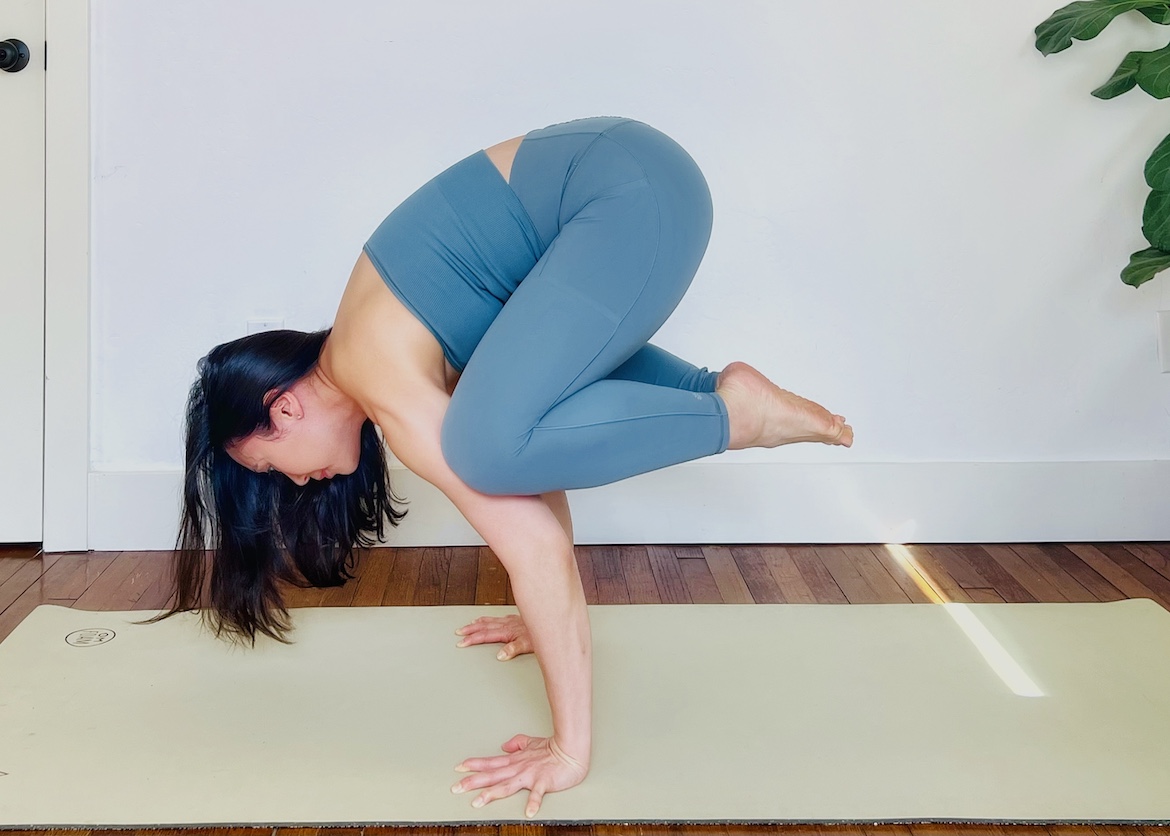
Step 6
How long you should hold crow pose depends on your endurance and experience level. Aim to hold the pose for 2 to 3 breath cycles if you are just starting out. Your wrists may feel fatigued if you are just starting to learn, so take a break when you need one. If you are more seasoned, you can hold for up to 5 breath cycles.
Step 7
To exit crow pose, slowly shift your weight back, gently lowering your feet back to the mat. Release your arms and return to a squatting position.
Step 8
Take a moment in a restful pose, such as child’s pose, to acknowledge the physical and mental effort, allowing your body and mind to assimilate the benefits of the practice.
Tips for mastering crow pose
Build core strength
Actively work on strengthening your core muscles through specific exercises like planks, boat pose, and leg raises. A strong core is fundamental for achieving a stable and balanced crow pose, as it helps you maintain your center of gravity.
Focus on hand placement
Pay attention to how you place your hands on the mat. Vivas offers some helpful advice: “It’s important to distribute your body weight into every part of the hands for a stable base and to avoid straining the wrists and arms.”
Spread your fingers wide and press down through the base of each finger. This hand placement not only provides a solid foundation but also spreads your weight out evenly, reducing the strain on your wrists.
Progress slowly
Start with basic arm balance preparatory poses, such as plank or chaturanga dandasana, to build the necessary arm strength. Practice simpler variations of crow pose, like keeping one foot on the ground, before attempting the full pose. Gradually increase the duration you hold the pose, starting from a few seconds to longer as you gain confidence and strength.
Be fearless
This is Vivas’s biggest take-home point: Let go of fear.
“If you are afraid you’ll fall, you’ll never allow yourself to go far enough forward to achieve the pose. The easiest thing to do is to place a pillow or a bolster in front of you to ensure a soft landing if you do end up going too far,” says Vivas. “Lean forward more than you think you need to, and keep trying again and again until you master it.”
Practice consistently
People often ask what is the “trick” to doing crow pose. Here is your answer: practice, practice, practice. Regular practice is key to mastering this exhilarating asana. Consistently integrating it into your yoga routine will steadily improve your balance and strength.
Focus on mindfulness and breath work
Stay mindful of your breath as you practice. Smooth, steady breathing can significantly aid in maintaining balance and focus in crow pose.
Seek feedback
If possible, practice crow pose under the guidance of a yoga instructor who can provide personalized feedback and adjustments, helping you refine your technique.
Practice patience—and perseverance
Mastering crow pose is a journey. Be patient with yourself and acknowledge that progress takes time. Celebrate the small victories along the way to stay motivated.
Variations of crow pose for all levels
Crow pose for beginner yogis
For those just starting, try crow pose with one foot remaining on the ground.
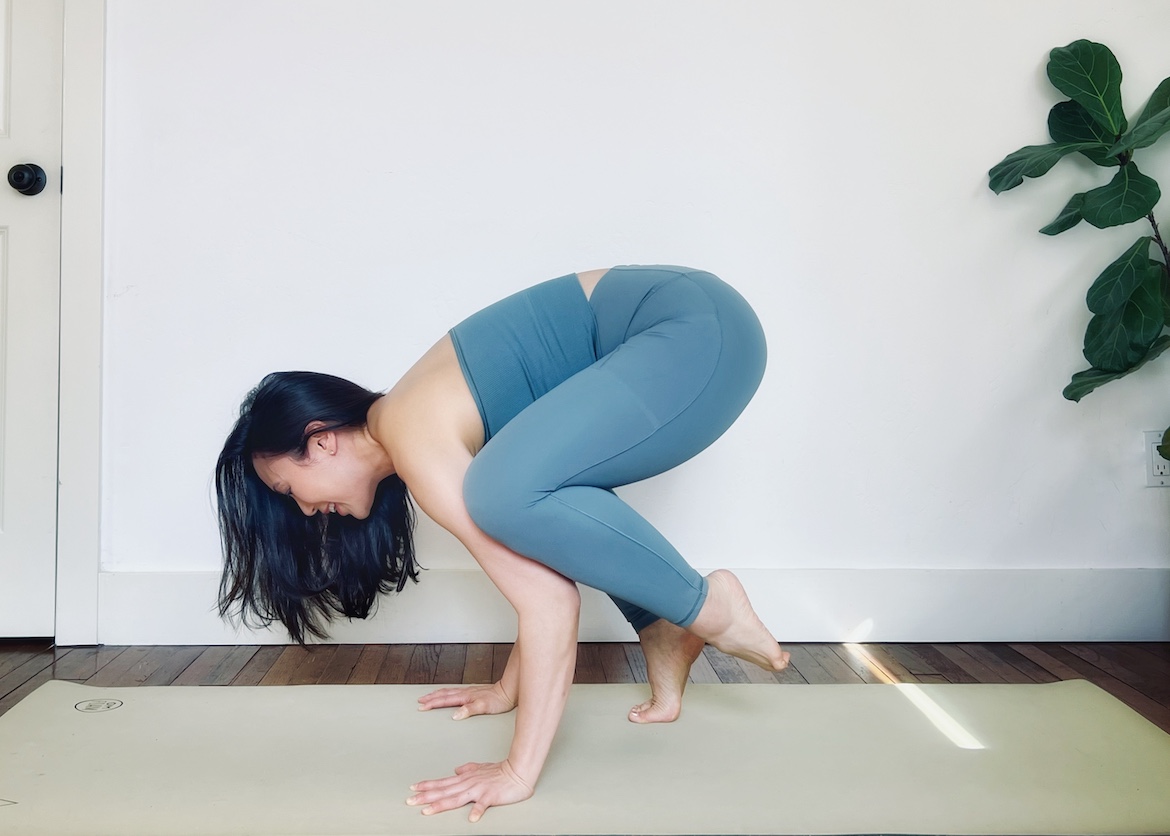
- Begin in a standard squat position. Don’t be shy about using props or cushions: Remember Vivas’s advice about putting a pillow in front of you if you’re afraid of falling forward.
- Place your hands on the ground, shoulder-width apart.
- Lift one foot off the ground while keeping the other foot as a stabilizing point on the mat.
- Gradually shift more weight onto your hands, raising the other foot when you feel confident.
- This approach allows beginners to get accustomed to the balance and strength required for full crow pose.
Side crow pose (advanced)
Side crow introduces a twist to the traditional crow pose, challenging your balance and core strength.
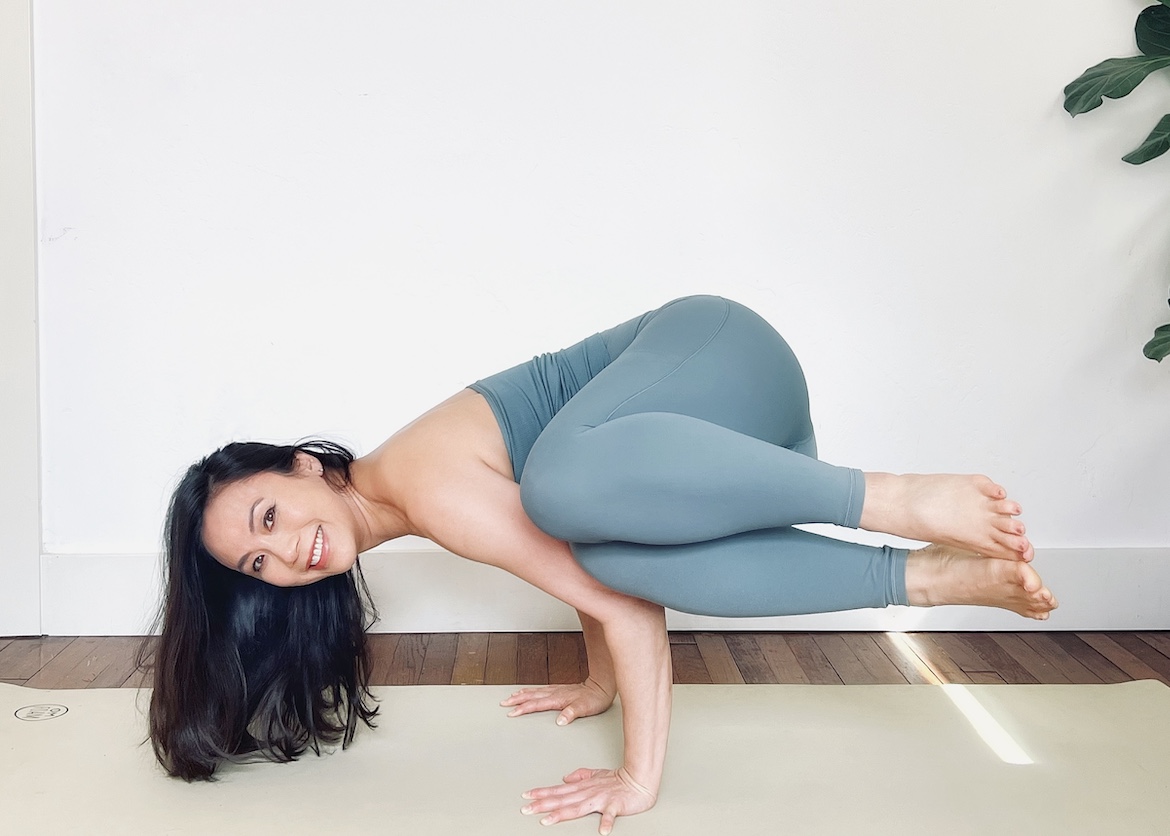
- Start in a squatting position.
- Twist your torso to one side, placing both hands on the mat beside you, aligned with your twisted direction.
- Position your knees onto one of your upper arms, close to the armpit.
- Shift your weight onto your hands, lifting both feet off the ground, balancing on one arm.
- This variation adds a twist to the core, enhancing oblique strength and balance.
Baby crow pose with blocks
Baby crow is an accessible starting point for those new to arm balances.
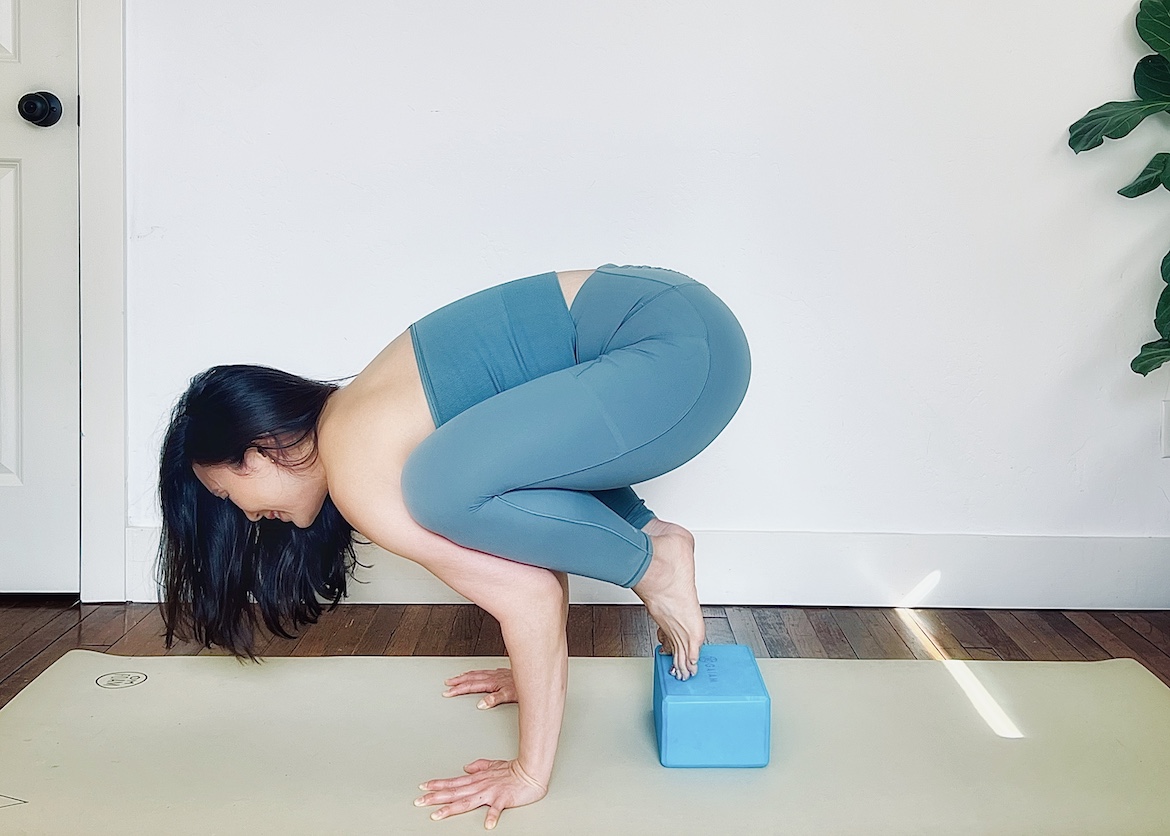
- Begin in a low squat with your feet on one or two blocks.
- Place your hands firmly on the mat in front of you
- Instead of placing your knees high up on your arms, position them closer to your elbows, reducing the lift needed.
- Lean forward, lifting one foot off the block, and then the other, just enough to feel the weight transfer to your hands.
- This version is less intimidating for those new to arm balances as it brings your balance up higher to begin with and helps in building confidence for full crow pose.
Here’s how to use two blocks, one at your feet and one at your head, to do crow pose the right way:
Crow vs. crane pose
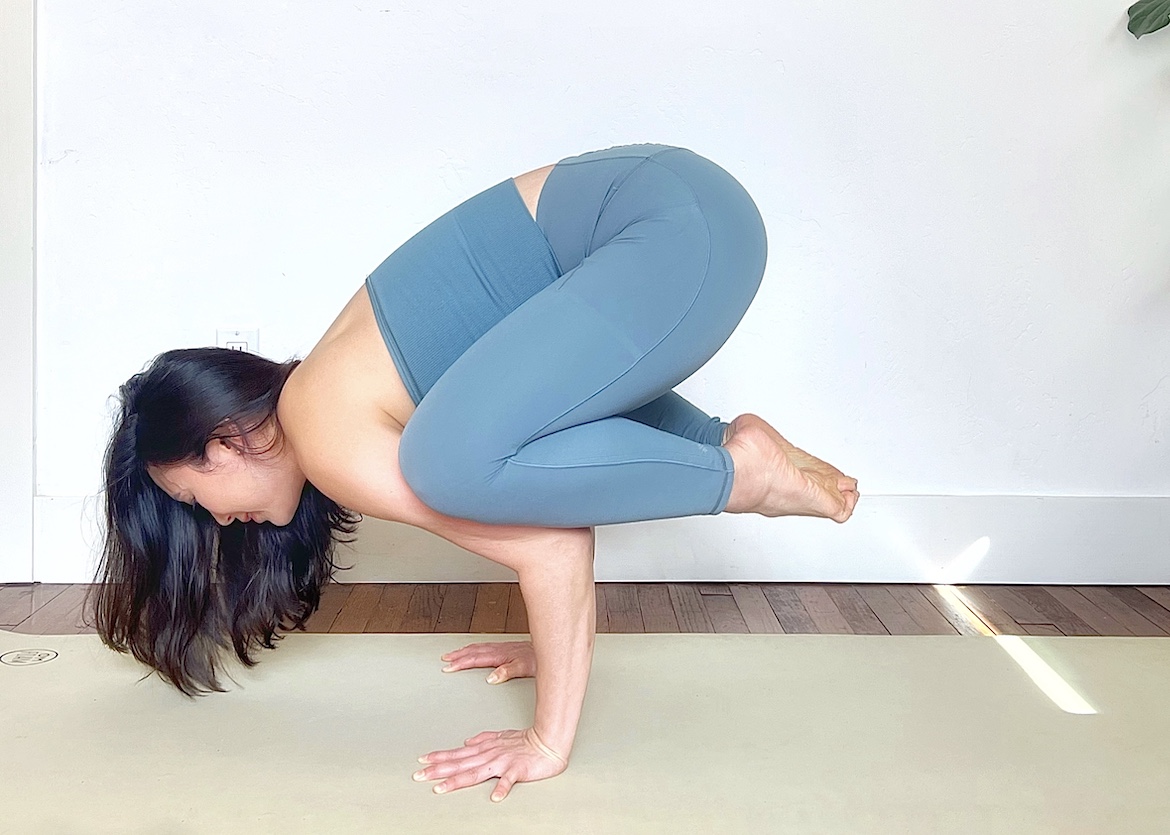
Crow pose (bakasana) and crane pose (kakasana) are both fundamental arm balances in yoga, but they differ in arm positioning, which affects their level of challenge.
In crane pose, the arms are bent at the elbows. This creates a more stable base for beginners or those building arm strength, as the knees rest on the upper arms. The lower center of gravity in crane pose makes it more accessible and easier to balance.
Alternatively, crow pose aspires toward straight arms. This demands more strength and balance, as the entire body’s weight is supported by the straight arms, raising the center of gravity.
Common crow pose mistakes and how to correct them
Hand and wrist misalignment
A frequent issue in crow pose is the misalignment of hands and wrists.
“The hands need to be firmly rooted shoulder-distance apart,” says Vivas, with the fingers spread wide. This setup provides a stable base, distributing your weight evenly across your hands. Pay attention to the pressure on your palms and fingers, adjusting as needed to maintain balance and reduce strain on your wrists.
Core collapse
Maintaining core strength is crucial in crow pose. A common mistake is letting the core collapse, which can lead to loss of balance and increased difficulty in sustaining the pose.
Engage your abdominal muscles by drawing your navel toward your spine, which helps keep your body compact and stable. Vivas says it can help to “round out your back and move the chest and gaze forward while strongly contracting the abdominals.” This engagement not only supports your balance but also protects your lower back from strain.
Strain in the neck
Many practitioners inadvertently strain their neck while trying to balance in crow pose. To avoid this, maintain a neutral neck position by keeping your gaze forward and slightly down. This alignment helps in balancing and reduces tension in the neck. Remember to relax your facial muscles and breathe deeply, as tension in the face can often lead to unnecessary neck strain.
Remember that mastering crow pose is about more than just physical prowess; it’s about cultivating a deep connection between mind and body. In your journey, remember Vivas’s words: “Not being afraid to fall in this practice can translate to greater bravery in other areas of your life. Mastering arm balancing postures demands concentration, perseverance, and fearlessness—qualities that can enrich all of our lives.”

